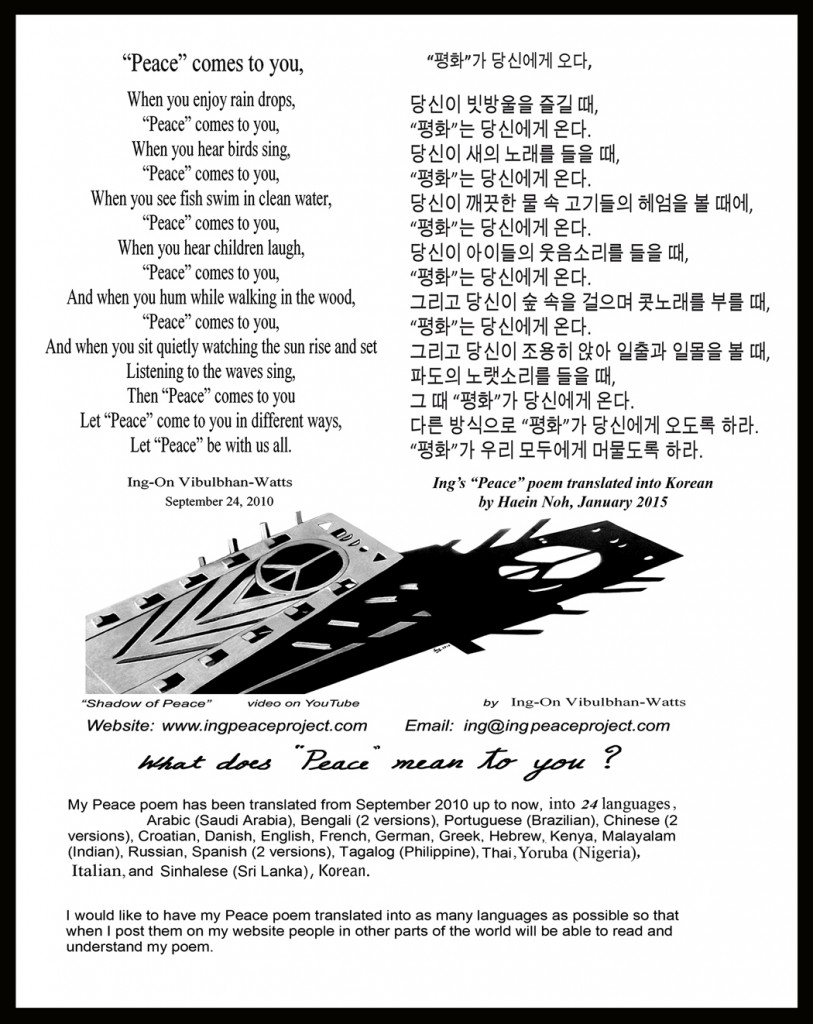 Ing’s “Peace Come to You” Poem
Ing’s “Peace Come to You” Poem
Translated into Korean by Haein Noh
January 2015
Hello,
I am a math teacher in the Paulo Freire Charter School. I met you at gallery in Newark with Ashley Hanania before. I translated the poem ‘peace comes to you.’ Attached file is Korean version. If you have any questions, please let me know.
Have a great day!*
Haein Noh**
Mathematics Teacher**The Paulo Freire Charter School*
Sun, January 11, 2015
Hi Haein Noh,
Thank you so much for translating my “Peace Come to You” poem into the Korean language. It is my best gift for the New Year of 2015. I am glad to know that you are a math teacher. I love math also. I have a young boy neighbor that comes to study math with me once a week on Saturday since he was six years old. His name is Hunter, now he is nine years old.
Our shop and art gallery is on 57 Halsey Street, Newark, NJ. If you have time please stop by our shop. You can see more of our artwork. My husband, John Watts is a playwright and pottery teacher. He teaches pottery summer classes at Rutgers University.
If you have time it would be nice if you can bring my Peace Poster to your school and introduce it to the students and teachers to write their comments on “What does Peace mean to you?”
I hope you and your family enjoyed your New Year celebration. I just uploaded “Ing’s Peace Sculptures and Painting” project on my Blog. The link is: https://ingpeaceproject.com/blog/
If you would like to know how I produced these sculptures please view the video on YouTube.“HappyNewYear2015IngPeaceSculptures”, the link is: https://youtu.be/zNcnrrMoPcA
All the best,
Ing
Chinese writing has been known in Korea for over 2,000 years. It was used widely during the Chinese occupation of northern Korea from 108 BC to 313 AD. By the 5th century AD, the Koreans were starting to write in Classical Chinese – the earliest known example of this dates from 414 AD. They later devised three different systems for writing Korean with Chinese characters: Hyangchal (??/??), Gukyeol (??/??) and Idu (??/??). These systems were similar to those developed in Japan and were probably used as models by the Japanese.
The Idu system used a combination of Chinese characters together with special symbols to indicate Korean verb endings and other grammatical markers, and was used to in official and private documents for many centuries. The Hyangchal system used Chinese characters to represent all the sounds of Korean and was used mainly to write poetry.
The Koreans borrowed a huge number of Chinese words, gave Korean readings and/or meanings to some of the Chinese characters and also invented about 150 new characters, most of which are rare or used mainly for personal or place names.
The Korean alphabet was invented in 1444 and promulgated it in 1446 during the reign of King Sejong (r.1418-1450), the fourth king of the Joseon Dynasty. The alphabet was originally called Hunmin jeongeum, or “The correct sounds for the instruction of the people”, but has also been known as Eonmeun (vulgar script) and Gukmeun (national writing). The modern name for the alphabet, Hangeul, was coined by a Korean linguist called Ju Si-gyeong (1876-1914). In North Korea the alphabet is known as ??? (josoen guel).
The shapes of the consonants are based on the shape the mouth made when the corresponding sound is made, and the traditional direction of writing (vertically from right to left) most likely came from Chinese, as did the practice of writing syllables in blocks.
Even after the invention of the Korean alphabet, most Koreans who could write continued to write either in Classical Chinese or in Korean using the Gukyeol or Idu systems. The Korean alphabet was associated with people of low status, i.e. women, children and the uneducated. During the 19th and 20th centuries a mixed writing system combining Chinese characters (Hanja) and Hangeul became increasingly popular. Since 1945 however, the importance of Chinese characters in Korean writing has diminished significantly.
Since 1949 hanja have not been used at all in any North Korean publications, with the exception of a few textbooks and specialized books. In the late 1960s the teaching of hanja was reintroduced in North Korean schools however and school children are expected to learn 2,000 characters by the end of high school.
In South Korea school children are expected to learn 1,800 hanja by the end of high school. The proportion of hanja used in Korean texts varies greatly from writer to writer and there is considerable public debate about the role of hanja in Korean writing.
Most modern Korean literature and informal writing is written entirely in hangeul, however academic papers and official documents tend to be written in a mixture of hangeul and hanja.
Notable features of Hangeul
- Type of writing system: alphabet
- Direction of writing: Until the 1980s Korean was usually written from right to left in vertical columns. Since then writing from left to right in horizontal lines has become popular, and today the majority of texts are written horizontally.
- Number of letter: 24 (jamo): 14 consonants and 10 vowels. The letters are combined together into syllable blocks.
- The shapes of the the consontants g/k, n, s, m and ng are graphical representations of the speech organs used to pronounce them. Other consonsants were created by adding extra lines to the basic shapes.
- The shapes of the the vowels are based on three elements: man (a vertical line), earth (a horizontal line) and heaven (a dot). In modern Hangeul the heavenly dot has mutated into a short line.
- Spaces are placed between words, which can be made up of one or more syllables.
- The sounds of some consonants change depending on whether they appear at the beginning, in the middle, or at the end of a syllable.
- A number of Korean scholars have proposed an alternative method of writing Hangeul involving writing each letter in a line like in English, rather than grouping them into syllable blocks, but their efforts have been met with little interest or enthusiasm.
- In South Korea hanja are used to some extent in some Korean texts.
Used to write
Korean (??? / ???), a language spoken by about 63 million people in South Korea, North Korea, China, Japan, Uzbekistan, Kazakhstan and Russia. The relationship between Korean and other languages is not known for sure, though some linguists believe it to be a member of the Altaic family of languages. Grammatically Korean is very similar to Japanese and about 70% of its vocabulary comes from Chinese.
A recording of the Korean consonants by Ng Kiat Quan
The double consonants marked with * are pronounced fortis. There is no symbol in IPA to indiciate this.
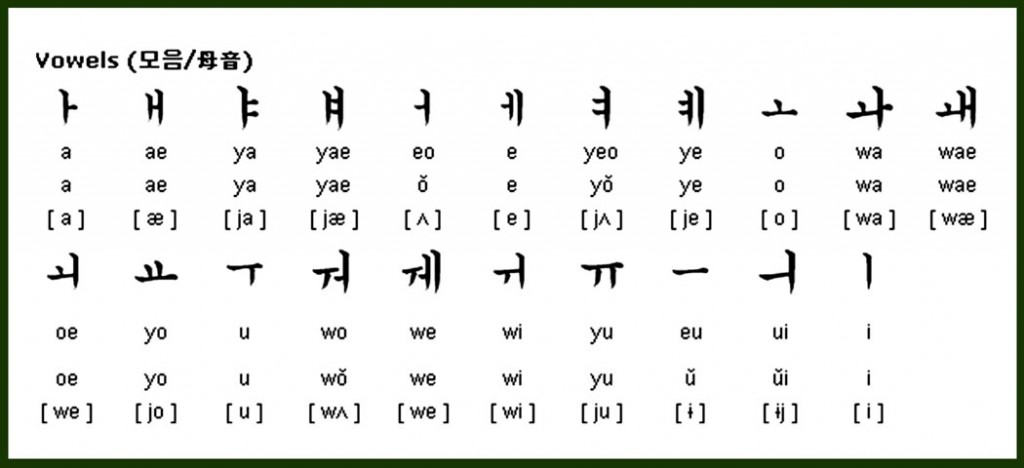 A recording of the Korean vowels by Ng Kiat Quan
A recording of the Korean vowels by Ng Kiat Quan
Note on the transliteration of Korean
There are a number different ways to write Korean in the Latin alphabet. The methods shown above are:
- (first row) the official South Korean transliteration system, which was introduced in July 2000. You can find further details at www.mct.go.kr.
- (second row) the McCune-Reischauer system, which was devised in 1937 by two American graduate students, George McCune and Edwin Reischauer, and is widely used in Western publications. For more details of this system see: https://mccune-reischauer.org
Download a Korean alphabet chart in Word or PDF format (letters arranged in South Korean order but without the double consonants).
Translation
All human beings are born free and equal in dignity and rights. They are endowed with reason and conscience and should act towards one another in a spirit of brotherhood.
(Article 1 of the Universal Declaration of Human Rights)
For more information please visit Omniglot website and others links are:
https://www.omniglot.com/writing/korean.htm
Information about Korean | Korean phrases | Korean numbers | Korean colours | Tower of Babel in Korean | Korean learning materials | Korean links
Information about the Korean language
https://ling.kgw.tu-berlin.de/Korean/Artikel01/Korean.htm
https://en.wikipedia.org/wiki/Korean_language
Online Korean lessons
https://rki.kbs.co.kr/learn_korean/lessons/e_index.htm
https://www.langintro.com/kintro/
https://www.learnkorean.com/
https://www.lifeinkorea.com/Language/korean.cfm
https://www.declan-software.com/korean.htm
https://hangulforest.com/index_e.htm
https://learnkorean.elanguageschool.net
https://english.visitkorea.or.kr/enu/CU/CU_EN_8_6_1_1_1.jsp
https://www.korean-course.com
https://learnkoreantoday.com
Learn to speak Korean confidently and naturally with Rocket Korean
Learn Korean with Glossika Mass Sentences
https://en.wikipedia.org/wiki/Korean_language
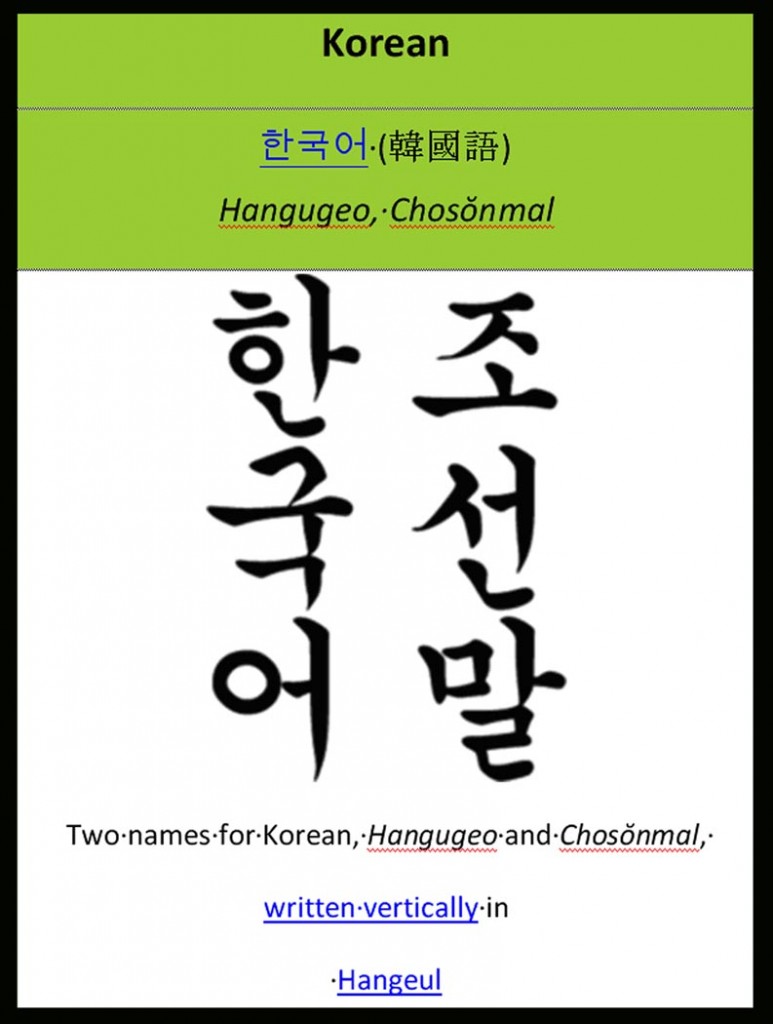 Korean (???/???, see below) is the official language of South Korea and North Korea, as well as one of the two official languages in China‘s Yanbian Korean Autonomous Prefecture. About 80 million people speak Korean worldwide. For over a millennium, Koreans wrote with adapted Chinese characters called hanja, complemented by phonetic systems like hyangchal, gugyeol, and idu. In the 15th century, Sejong the Great commissioned a national writing system called Hangeul, but it only came into widespread use in the 20th century, because of the yangban aristocracy’s preference for hanja.
Korean (???/???, see below) is the official language of South Korea and North Korea, as well as one of the two official languages in China‘s Yanbian Korean Autonomous Prefecture. About 80 million people speak Korean worldwide. For over a millennium, Koreans wrote with adapted Chinese characters called hanja, complemented by phonetic systems like hyangchal, gugyeol, and idu. In the 15th century, Sejong the Great commissioned a national writing system called Hangeul, but it only came into widespread use in the 20th century, because of the yangban aristocracy’s preference for hanja.
Some historical linguists classify Korean as a language isolate,[3][4][5][6][7][8] whereas others consider it to be in the controversial Altaic language family.[9] The Korean language is agglutinative in its morphology and SOV in its syntax.
The Korean names for the language are based on the names for Korea used in North and South Korea.
In South Korea, the language is most often called Hangungmal (???), consisting of Hanguk (??, /h??nguk?/), the South Korean name for Korea, and mal (?, /mal/), meaning “speech”; the /k?/ at the end of the first word becomes /?/ by the rules of consonant assimilation in Korean phonology. More formally, it may also be called Hangugeo (???) or Gugeo (??; literally “national language”).[citation needed]
In North Korea and Yanbian Korean Autonomous Prefecture in China, the language is most often called Chos?nmal (???), or more formally, Chos?n? (???).[citation needed]
The English word “Korean” is derived from Goryeo (??), which is thought to be the first dynasty known to Western countries. Korean people in the former USSR, who refer to themselves as Koryo-saram (????; also Goryeo In [???; ???; literally, “Goryeo person(s)”]) call the language Goryeo Mal (???).
In mainland China, following the establishment of diplomatic relations with South Korea in 1992, the term Cháoxi?ny? (??? or the short form: Cháoy? (??)) has normally been used to refer to the standard language of North Korea and Yanbian, whereas Hánguóy? (??? or the short form: Hány? (??)) is used to refer to the standard language of South Korea.[citation needed]
Some older English sources also use the spelling “Corean” to refer to the language, country, and people.[citation needed]
Korean is far from the Altaic languages in most grammatical elements, including articles, fusional morphology, and relative pronouns. Since Ramstedt‘s 1928 article, some linguists[10] support the hypothesis that Korean can be classified as an Altaic language or as a relative of proto-Altaic. However, linguists agree today that typological resemblances cannot be used to prove genetic relatedness of languages,[11] as these features are typologically connected and easily borrowed.[12] Such factors of typological divergence as Middle Mongolian’s exhibition of gender agreement[13] can be used to argue that a genetic relationship is unlikely.[14]
The hypothesis that Korean might be related to Japanese has had some supporters due to some apparent overlap in vocabulary and similar grammatical features that have been elaborated upon by such researchers as Samuel E. Martin[15] and Roy Andrew Miller.[16] Sergei Anatolyevich Starostin (1991) found about 25% of potential cognates in the Japanese–Korean 100-word Swadesh list, which—if valid—would place these two languages closer together than other possible members of the Altaic family.[17]
Some linguists, most notably Alexander Vovin, have argued that the indicated similarities between Japanese and Korean are not due to any genetic relationship, but rather to a sprachbund effect and heavy borrowing, especially from ancient Korean into Western Old Japanese.[18] A good example might be Middle Korean sàm and Japanese asa “hemp”.[19] This word seems to be a cognate, but although it is well-attested in Western Old Japanese and Northern Ry?ky?, in Eastern Old Japanese it only occurs in compounds, and it is only present in three subdialects of the South-Ry?ky?an dialect group. Then, the doublet wo “hemp” is attested in Western Old Japanese and Southern Ry?ky?. It is thus plausible to assume a borrowed term.[20] (See Classification of Japonic languages for further details on a possible relationship.)
Among ancient languages, various closer relatives of Korean have been proposed, constituting a possible small Koreanic language family. Some classify the language of Jeju Island as a distinct modern Koreanic language.
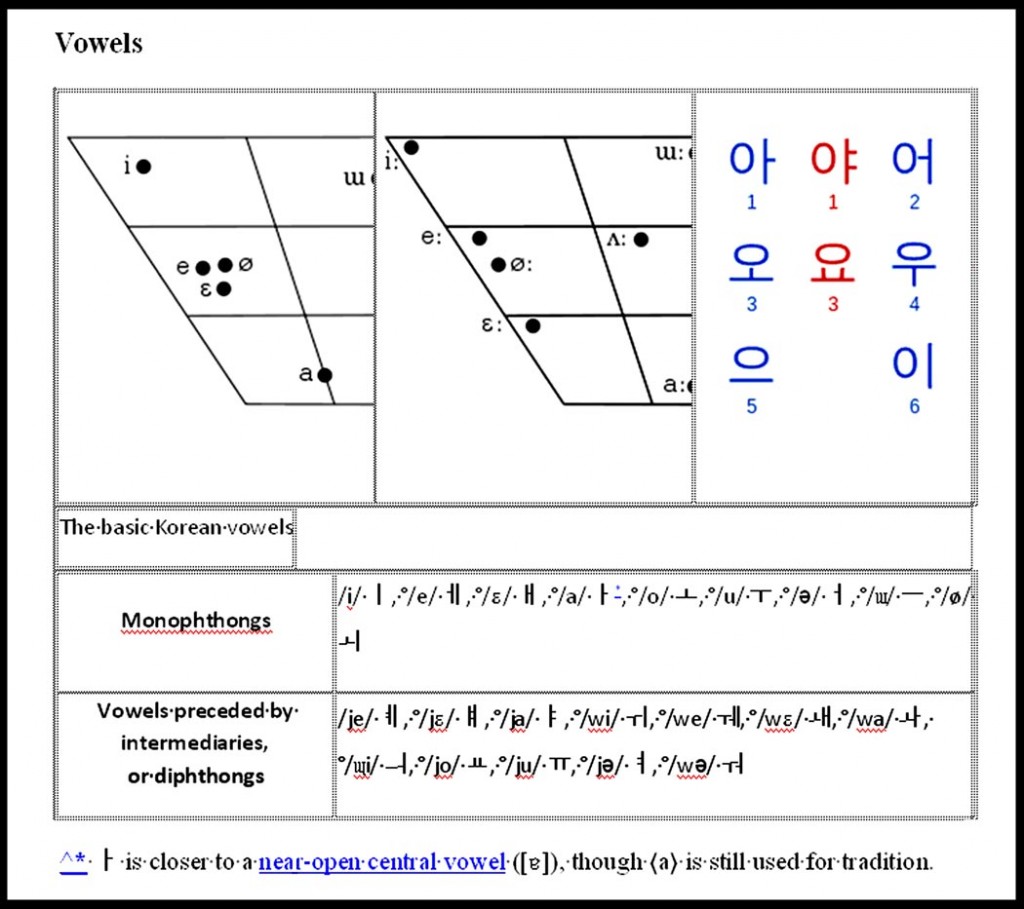
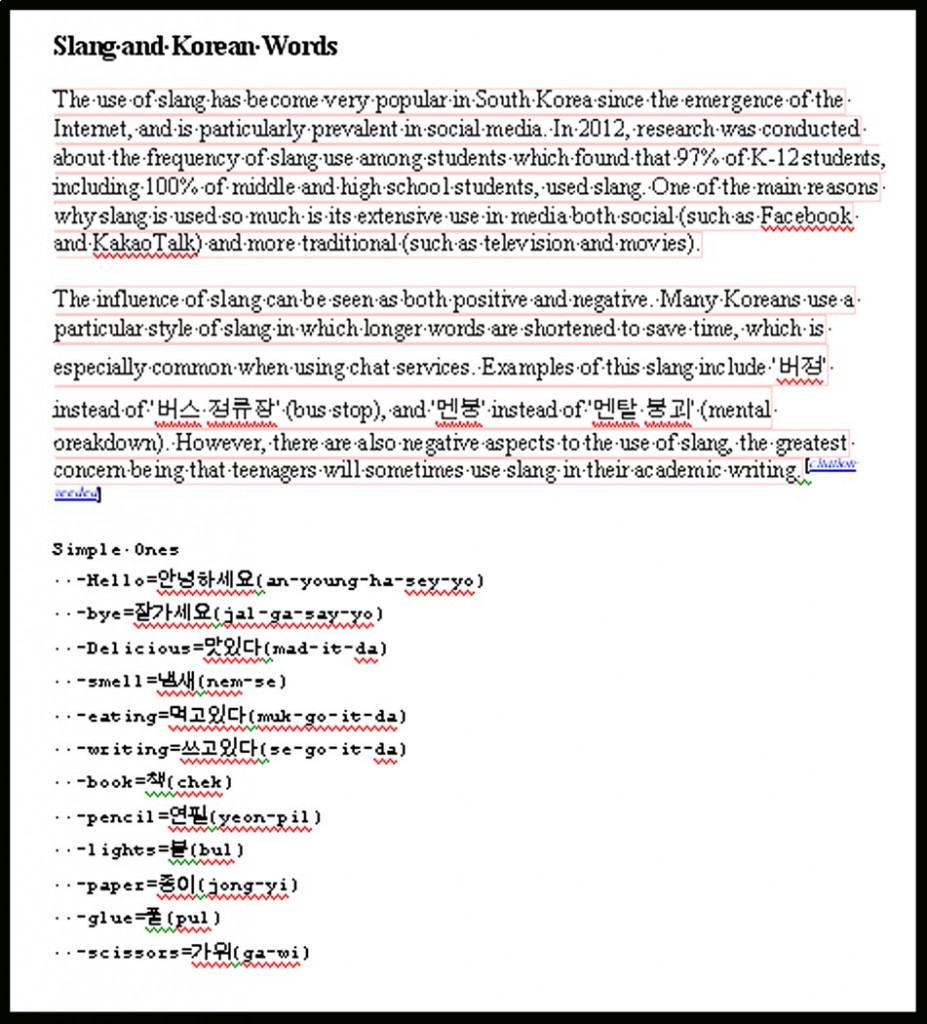 For more information please visit the following link:
For more information please visit the following link:
https://en.wikipedia.org/wiki/Korea
President of the ROK Park Geun-hye
Supreme Leader of the DPRK Kim Jong-un
Total 219,140 km2[1][2] 84,610 sq mi
Water (%) 2.8
2010 estimate 74,000,000[3]
Density 328.49/km2 850.7/sq mi
Currency North Korean won (?) South Korean won (?)
This article contains Korean text. Without proper rendering support, you may see question marks, boxes, or other symbols instead of Hangul and hanja.
Korea, called Hanguk (Korean: ??; Hanja: ??) in South Korea and Joseon (Korean: ??; Hanja: ??) in North Korea, is an East Asian territory that is divided into two distinct sovereign states, North Korea (a.k.a. Democratic People’s Republic of Korea, or DPRK) and South Korea (a.k.a. Republic of Korea, or ROK). Located on the Korean Peninsula, Korea is bordered by China to the northwest and Russia to the northeast. It is separated from Japan to the east by the Korea Strait and the East Sea . The adoption of the Chinese writing system (“Hanja” Korean: ?? in Korean) in the 2nd century BC and the introduction of Buddhism in the 4th century AD had profound effects on the Three Kingdoms of Korea, which were first united during Silla (57 BC – AD 935) under King Munmu. The united Silla fell to Goryeo in 935 at the end of the Later Three Kingdoms period. Goryeo was a highly cultured state and created the Jikji in the 14th century. The invasions by the Mongolians in the 13th century, however, greatly weakened the nation, which was forced to become a tributary state. After the Mongol Empire‘s collapse, severe political strife followed. The Ming-allied Joseon emerged supreme in 1388.
The first 200 years of Joseon were marked by relative peace and saw the creation of the Korean Hangul alphabet by King Sejong the Great in the 14th century and the increasing influence of Confucianism. During the later part of the dynasty, however, Korea’s isolationist policy earned it the Western nickname of the “Hermit kingdom“. By the late 19th century, the country became the object of the colonial designs by Japan. In 1910, Korea was annexed by Japan and remained a colony until the end of World War II in August 1945.
In 1945, the Soviet Union and the United States agreed on the surrender of Japanese forces in Korea in the aftermath of World War II, leaving Korea partitioned along the 38th parallel, with the north under Soviet occupation and the south under U.S. occupation. These circumstances soon became the basis for the division of Korea by the two superpowers, exacerbated by their inability to agree on the terms of Korean independence. The two Cold War rivals then established governments centered on their own respective ideologies, leading to Korea’s division into two political entities: North Korea and South Korea. This eventually led to war in 1950, which became the Korean War.
“Korea” is the modern spelling of Corea, a name attested in English as early as 1614.[4] It is an exonym derived from Cauli, Marco Polo‘s transcription[5] of the Chinese ?? (simp.???, MC?Kawlej,[6] mod.?G?olì). This was the Hanja for the Korean kingdom of Goryeo or Kory? (??; 918–1392), which ruled most of the peninsula during the time of his travels. (Scholars who discount the historicity of Polo’s account instead derive it via Persian variations of the same Chinese name.[7]) Goryeo’s name was an homage to the earlier Goguryeo or Koguryo (???; 37?BC – AD?668), the northernmost of the Samkuk (the Three Kingdoms of Korea), which was officially known by the shortened form Goryeo after the 5th-century reign of King Jangsu. The original name was a combination of the adjective go (“high, lofty”) with the name of a local Yemaek tribe, whose original name is thought to have been either *Guru (??, “walled city,” inferred from some toponyms in Chinese historical documents) or *Gauri (???, “center”). With expanding British and American trade following the opening of Korea in the late 19th century, the spelling “Korea” appeared and gradually grew in popularity;[4] its use in transcribing East Asian languages avoids the issues caused by the separate hard and soft Cs existing in English vocabulary derived from the Romance languages. The name Korea is now commonly used in English contexts by both North and South Korea.
In South Korea, Korea as a whole is referred to as Hanguk (??, [ha?n?uk], lit.?”country of the Han“). The name references the Samhan—Ma, Jin, and Byeon—who preceded the Three Kingdoms in the southern and central end of the peninsula during the 1st centuries?BC and AD. Although written in Hanja as ?, ?, or ?, this Han has no relation to the Chinese place names or peoples who used those characters but was a phonetic transcription (OC😕*Gar, MC?Han[6] or Gan) of a native Korean word that seems to have had the meaning “big” or “great”, particularly in reference to leaders. It has been tentatively linked with the title khan used by the nomads of Manchuria and Central Asia.
In North Korea, Korea as a whole is referred to as Chos?n (??, Joseon, [t?os??n], lit.?”[land of the] Morning Calm”). “Great Joseon” was the name of the kingdom ruled by the Joseon dynasty from 1393 until their declaration of the short-lived Great Korean Empire in 1897. King Taejo had named them for the earlier Kojoseon (???), who ruled northern Korea from its legendary prehistory until their conquest in 108?BC by China’s Han Empire. This go is the Hanja ? and simply means “ancient” or “old”; it’s a modern usage to distinguish the ancient Joseon from the later dynasty. Joseon itself is the modern Korean pronunciation of the Hanja ?? but it remains unclear whether this was a transcription of a native Korean name (OC?*T[r]awser, MC?Trjewsjen[6]) or a partial translation into Chinese of the Korean capital Asadal (???),[8] whose meaning has been reconstructed as “Morning Land” or “Mountain”.
Ancient Gojoseon Wiman Joseon Jin state
Proto–Three Kingdoms Buyeo Goguryeo Okjeo Dongye Samhan Ma Byeon Jin
Goguryeo 37 BC–668 AD
Baekje 18 BC–660 AD
Silla 57 BC–935 AD
Gaya confederacy 42–562
Unified Silla 668–935
Balhae 698–926
Later Baekje 892–936
Taebong (Later Goguryeo) 901–918
Silla 57 BC–935 AD
Unitary dynastic period
Goryeo 918–1392
Joseon 1392–1897
Korean Empire 1897–1910
Colonial period
Japanese rule 1910–45
Provisional Government 1919–48
Military Governments 1945–48
North Korea 1948–present
South Korea 1948–present
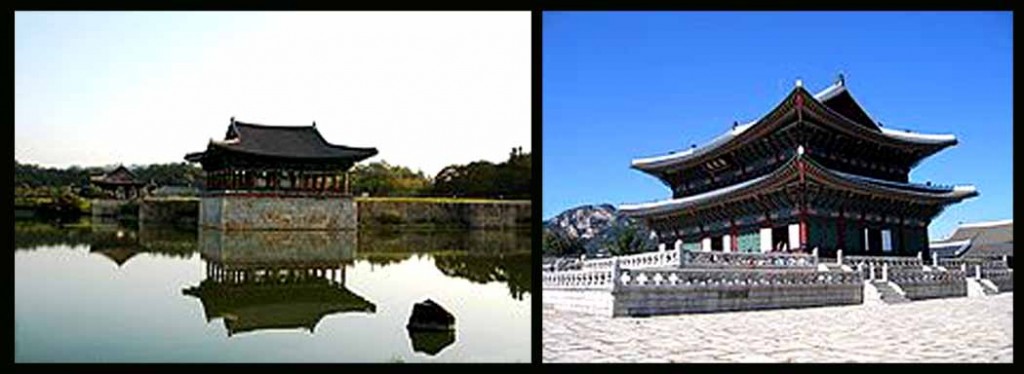 Left: Anapji (Anap Pond) in Gyeongju Historic Areas.
Left: Anapji (Anap Pond) in Gyeongju Historic Areas.
Right: the Gyeongbokgung Palace
Korean Empire
The earliest surviving depiction of the Korean flag was printed in a US Navy book Flags of Maritime Nations in July 1889.
Main article: Korean Empire
Further information: Gwangmu Reform
Beginning in 1871, Japan began to force Korea out of the Manchu Qing Dynasty’s traditional sphere of influence into its own. As a result of the Sino-Japanese War (1894–95), the Qing Dynasty had to give up such a position according to Article 1 of the Treaty of Shimonoseki, which was concluded between China and Japan in 1895. That same year, Empress Myeongseong was assassinated by Japanese agents.[27]
In 1897, the Joseon dynasty proclaimed the Korean Empire (1897–1910), and King Gojong became Emperor Gojong. This brief period saw the partially successful modernisation of the military, economy, real property laws, education system, and various industries, influenced by the political encroachment into Korea of Russia, Japan, France, and the United States.
In 1904, the Russo-Japanese War pushed the Russians out of the fight for Korea. In Manchuria on October 26, 1909, An Jung-geun assassinated the former Resident-General of Korea, It? Hirobumi for his role in trying to force Korea into occupation.
Japanese occupation
Main article: Korea under Japanese rule
See also: Japanese war crimes
The memorial tablet for the March 1st movement in Pagoda Park, Seoul
In 1910, an already militarily occupied Korea was a forced party to the Japan-Korea Annexation Treaty. The treaty was signed by Lee Wan-Yong, who was given the General Power of Attorney by the Emperor. However, the Emperor is said to have not actually ratified the treaty according to Yi Tae-jin.[28] There is a long dispute whether this treaty was legal or illegal due to its signing under duress, threat of force and bribes.
Korean resistance to the brutal Japanese occupation[29][30][31] was manifested in the nonviolent March 1st Movement of 1919, during which 7,000 demonstrators were killed by Japanese police and military.[32] The Korean liberation movement also spread to neighbouring Manchuria and Siberia.
Over five million Koreans were conscripted for labour beginning in 1939,[33] and tens of thousands of men were forced into Japan’s military.[34] Nearly 400,000 Korean labourers died.[35] Approximately 200,000 girls and women,[36] mostly from China and Korea, were forced into sexual slavery for the Japanese military.[37] In 1993, Japanese Chief Cabinet Secretary Yohei Kono acknowledged the terrible injustices faced by these euphemistically named “comfort women“.[38][39]
During the Japanese Colonial rule, the Korean language was suppressed in an effort to eradicate Korean national identity. Koreans were forced to take Japanese surnames, known as S?shi-kaimei.[40] Traditional Korean culture suffered heavy losses, as numerous Korean cultural artifacts were destroyed[41] or taken to Japan.[42] To this day, valuable Korean artifacts can often be found in Japanese museums or among private collections.[43] One investigation by the South Korean government identified 75,311 cultural assets that were taken from Korea, 34,369 in Japan and 17,803 in the United States. However, experts estimate that over 100,000 artifacts actually remain in Japan.[42][44] Japanese officials considered returning Korean cultural properties, but to date[42] this has not occurred.[44] Korea and Japan still dispute the ownership of the Dokdo, islets located east of the Korean Peninsula.[45]
There was a significant level of emigration to the overseas territories of the Empire of Japan during the Japanese colonial period, including Korea.[46] By the end of World War II, there were over 850,000 Japanese settlers in Korea.[47] After World War II, most of these overseas Japanese repatriated to Japan.
Korean War
Main article: Korean War
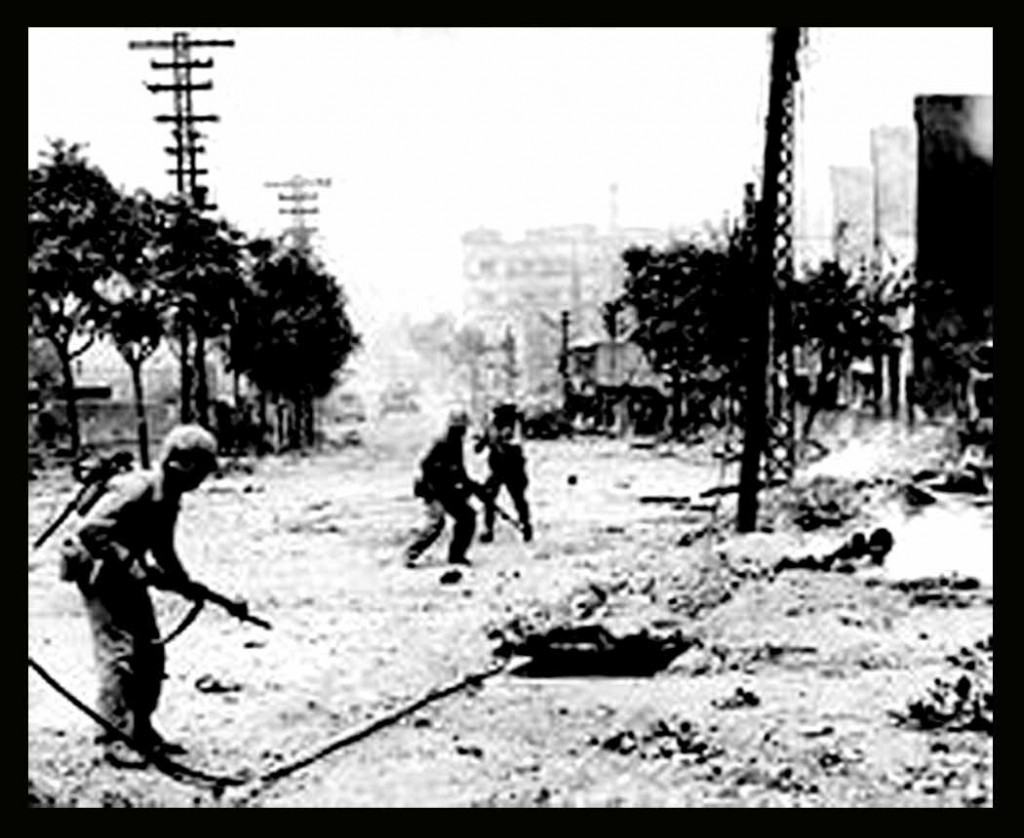 Urban combat in Seoul, 1950, as US Marines fight North Koreans holding the city.
Urban combat in Seoul, 1950, as US Marines fight North Koreans holding the city.
With the surrender of Japan in 1945 the United Nations developed plans for a trusteeship administration, the Soviet Union administering the peninsula north of the 38th parallel and the United States administering the south. The politics of the Cold War resulted in the 1948 establishment of two separate governments, North Korea and South Korea.
In June 1950 North Korea invaded the South, using Soviet tanks and weaponry. During the Korean War (1950–53) more than one million people died and the three years of fighting throughout the nation effectively destroyed most cities.[48] The war ended in an Armistice Agreement at approximately the Military Demarcation Line.
Division
 Left:Flag of North Korea Right: Flag of South Korea
Left:Flag of North Korea Right: Flag of South Korea
Main articles: Division of Korea and Korean reunification
The aftermath of World War II left Korea partitioned along the 38th parallel, with the north under Soviet occupation and the south under US occupation supported by other allied states. Consequently, the Democratic People’s Republic of Korea, a Soviet-style socialist republic, was established in the north while the Republic of Korea, a Western-style regime, was established in the South. The Korean War broke out when Soviet-backed North Korea invaded South Korea, though neither side gained much territory as a result. The Korean Peninsula remains divided, the Korean Demilitarized Zone being the de facto border between the two states.
Since the 1960s, the South Korean economy has grown enormously and the economic structure was radically transformed. In 1957 South Korea had a lower per capita GDP than Ghana,[49] and by 2008 it was 17 times as high as Ghana’s.[a]
North Korea, officially the Democratic People’s Republic of Korea, is a single-party state, now centred on Kim Il-sung‘s Juche ideology, with a centrally planned industrial economy. South Korea, officially the Republic of Korea, is a multi-party state with a capitalist market economy, alongside membership in the Organisation for Economic Co-operation and Development and the Group of Twenty. The two states have greatly diverged both culturally and economically since their partition, though they still share a common traditional culture and pre-Cold War history.
According to R.J. Rummel, forced labor, executions, and concentration camps were responsible for over one million deaths in North Korea from 1948 to 1987;[51] others have estimated 400,000 deaths in concentration camps alone.[52] Estimates based on the most recent North Korean census suggest that 240,000 to 420,000 people died as a result of the 1990s famine and that there were 600,000 to 850,000 unnatural deaths in North Korea from 1993 to 2008.[53]
Tensions continue to this day, but the political arena is a far more complicated one. Recently the U.S. has expressed concerns over North Korea’s provocation of South Korea by carrying out shelling of the island of Yeonpyeong, which itself lies on a disputed sea border between the two countries.[54][55][56]
Geography
Main article: Geography of Korea
See also: Geography of North Korea, Geography of South Korea and Provinces of Korea
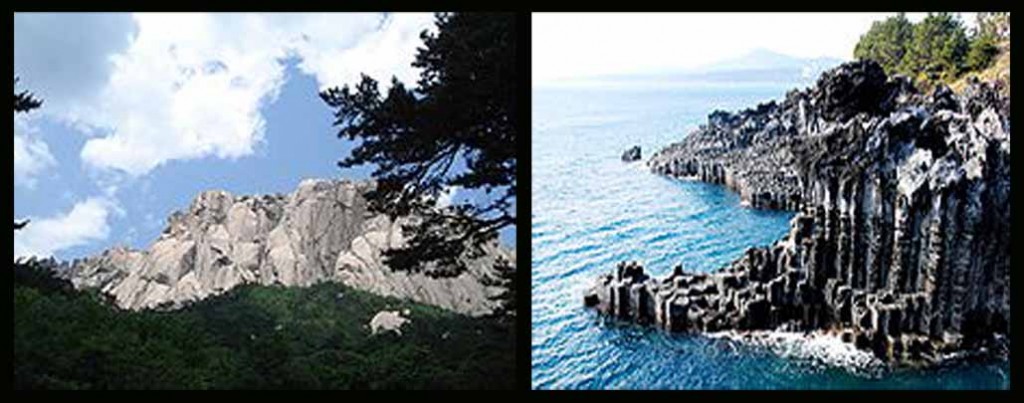 Left: A view of Mount Seorak Right: Jeju Island seashore
Left: A view of Mount Seorak Right: Jeju Island seashore
Korea is located on the Korean Peninsula in North-East Asia. To the northwest, the Amnok River (Yalu River) separates Korea from China and to the northeast, the Duman River (Tumen River) separates Korea from China and Russia. The peninsula is surrounded by the Yellow Sea to the west, the East China Sea and Korea Strait to the south, and the Sea of Japan to the east.[57] Notable islands include Jeju Island (Jejudo), Ulleung Island (Ulleungdo), and Liancourt Rocks (Dokdo).
The southern and western parts of the peninsula have well-developed plains, while the eastern and northern parts are mountainous. The highest mountain in Korea is Mount Paektu or Paektusan (2,744 m), through which runs the border with China. The southern extension of Mount Paektu is a highland called Gaema Heights. This highland was mainly raised during the Cenozoic orogeny and partly covered by volcanic matter. To the south of Gaema Gowon, successive high mountains are located along the eastern coast of the peninsula. This mountain range is named Baekdudaegan. Some significant mountains include Mount Sobaek or Sobaeksan (1,439 m), Mount Kumgang or Kumgangsan (1,638 m), Mount Seorak or Seoraksan (1,708 m), Mount Taebaek or Taebaeksan (1,567 m), and Mount Jiri or Jirisan (1,915 m). There are several lower, secondary mountain series whose direction is almost perpendicular to that of Baekdudaegan. They are developed along the tectonic line of Mesozoic orogeny and their directions are basically northwest.
Unlike most ancient mountains on the mainland, many important islands in Korea were formed by volcanic activity in the Cenozoic orogeny. Jeju Island, situated off the southern coast, is a large volcanic island whose main mountain Mount Halla or Hallasan (1950 m) is the highest in South Korea. Ulleung Island is a volcanic island in the East Sea, whose composition is more felsic than Jeju-do. The volcanic islands tend to be younger, the more westward.
Because the mountainous region is mostly on the eastern part of the peninsula, the main rivers tend to flow westwards. Two exceptions are the southward-flowing Nakdong River (Nakdonggang) and Seomjin River (Seomjingang). Important rivers running westward include the Amnok River, the Chongchon River (Chongchongang), the Taedong River (Taedonggang), the Han River (Hangang), the Geum River (Geumgang), and the Yeongsan River (Yeongsangang). These rivers have vast flood plains and provide an ideal environment for wet-rice cultivation.
The southern and southwestern coastlines of Korea form a well-developed ria coastline, known as Dadohae-jin in Korean. Its convoluted coastline provides mild seas, and the resulting calm environment allows for safe navigation, fishing, and seaweed farming. In addition to the complex coastline, the western coast of the Korean Peninsula has an extremely high tidal amplitude (at Incheon, around the middle of the western coast. It can get as high as 9 m). Vast tidal flats have been developing on the south and west coastlines.
Wildlife
Main article: Wildlife of Korea
Animal life of Korea includes a considerable number of bird species and native freshwater fish. Native or endemic species of the Korean Peninsula include Korean hare, Korean water deer, Korean field mouse, Korean brown frog, Korean pine and Korean spruce. The Korean Demilitarized Zone (DMZ) with its forest and natural wetlands is a unique biodiversity spot, which harbours eighty two endangered species.
There are also approximately 3,034 species of vascular plants.
Demographics
Main articles: Koreans, Demographics of South Korea and Demographics of North Korea
The combined population of the Koreans is about 73 million (North Korea: 23 million, South Korea: 50 million). Korea is chiefly populated by a highly homogeneous ethnic group, the Koreans, who speak the Korean language.[58] The number of foreigners living in Korea has also steadily increased since the late 20th century, particularly in South Korea, where more than 1 million foreigners reside.[59] It was estimated in 2006 that only 26,700 of the old Chinese community now remain in South Korea.[60] However, in recent years, immigration from mainland China has increased; 624,994 persons of Chinese nationality have immigrated to South Korea, including 443,566 of ethnic Korean descent.[61] Small communities of ethnic Chinese and Japanese are also found in North Korea.[62] The baekjeong were an “untouchable” outcaste group of Korea, often compared with the burakumin of Japan and the dalits of India.[63]
Culture and arts
 Left: Korean Buddhist architecture Right: Traditional Korean dance (Jinju geommu)
Left: Korean Buddhist architecture Right: Traditional Korean dance (Jinju geommu)
Main articles: Culture of Korea, Korean art, Korean pottery and porcelain, Korean martial arts, Korean dance, Korean bow and Korean architecture
In ancient Chinese texts, Korea is referred to as “Rivers and Mountains Embroidered on Silk” (????, ????) and “Eastern Nation of Decorum” (??????, ??????).[64] Individuals are regarded as one year old when they are born, as Koreans reckon the pregnancy period as one year of life for infants, and age increments increase on New Year’s Day rather than on the anniversary of birthdays. Thus, one born immediately before New Year’s Day may only be a few days old in western reckoning, but two years old in Korea. Accordingly, a Korean person’s stated age (at least among fellow Koreans) will be one or two years more than their age according to western reckoning. However, western reckoning is sometimes applied with regard to the concept of legal age; for example, the legal age for purchasing alcohol or cigarettes in the Republic of Korea is 19, which is measured according to western reckoning.
Literature
Main article: Korean literature
Korean literature written before the end of the Joseon Dynasty is called “Classical” or “Traditional.” Literature, written in Chinese characters (hanja), was established at the same time as the Chinese script arrived on the peninsula. Korean scholars were writing poetry in the classical Korean style as early as the 2nd century?BC, reflecting Korean thoughts and experiences of that time. Classical Korean literature has its roots in traditional folk beliefs and folk tales of the peninsula, strongly influenced by Confucianism, Buddhism and Taoism.
Modern literature is often linked with the development of hangul, which helped spread literacy from the aristocracy to the common men and women. Hangul, however, only reached a dominant position in Korean literature in the second half of the 19th century, resulting in a major growth in Korean literature. Sinsoseol, for instance, are novels written in hangul.
The Korean War led to the development of literature centered on the wounds and chaos of war. Much of the post-war literature in South Korea deals with the daily lives of ordinary people, and their struggles with national pain. The collapse of the traditional Korean value system is another common theme of the time.
Music
Main article: Music of Korea
Korean music includes both folk and classical music. The country has produced internationally prominent composers. Young-ja Lee is one example. She was born in 1931 in Wonju and studied at the Conservatoire de Paris, and the Royal Conservatory of Brussels. She continued her education at the Manhattan School of Music. Lee endured hardships during the Japanese occupation and Korean War, but emerged to become one of the dominant forces in Korean music in the 20th century.[65]
Cuisine
Main article: Korean cuisine
See also: Korean tea ceremony and Korean royal court cuisine
Korean cuisine is probably best known for kimchi, a side dish which uses a distinctive fermentation process of preserving vegetables, most commonly cabbage. Kimchi is said to relieve the pores on the skin, thereby reducing wrinkles and providing nutrients to the skin naturally. It is also healthy, as it provides necessary vitamins and nutrients. Gochujang (Korean traditional sauce made of red pepper) is also commonly used, often as pepper (chilli) paste, earning the cuisine a reputation for being spicy.
Bulgogi (roasted marinated meat, usually beef), galbi (marinated grilled short ribs), and samgyeopsal (pork belly) are popular meat entrees. Fish is also a popular commodity, as it is the traditional meat that Koreans eat. Meals are usually accompanied by a soup or stew, such as galbitang (stewed ribs) and doenjang jjigae (fermented bean paste soup). The center of the table is filled with a shared collection of sidedishes called banchan.
Other popular dishes include bibimbap which literally means “mixed rice” (rice mixed with meat, vegetables, and red pepper paste) and naengmyeon (cold noodles).
Instant noodles are also a very popular snack food. Koreans also enjoy food from pojangmachas (street vendors), where one can buy ddeokbokki (rice cake and fish cake with a spicy gochujang sauce), gimbap, and fried squid and glazed sweet potato. Soondae, a sausage made of cellophane noodles and pork blood, is widely eaten. There is also an instant noodle called “Ramyun“.
Additionally, some other common snacks include “Choco Pie“, shrimp crackers, “bbungtigi” (fried rice cracker), and “nureongji” (slightly burnt rice). Nureongji can be eaten as it is or boiled with water to make a soup. Nureongji can be eaten as a snack or a dessert.
Education
Education in North Korea and Education in South Korea
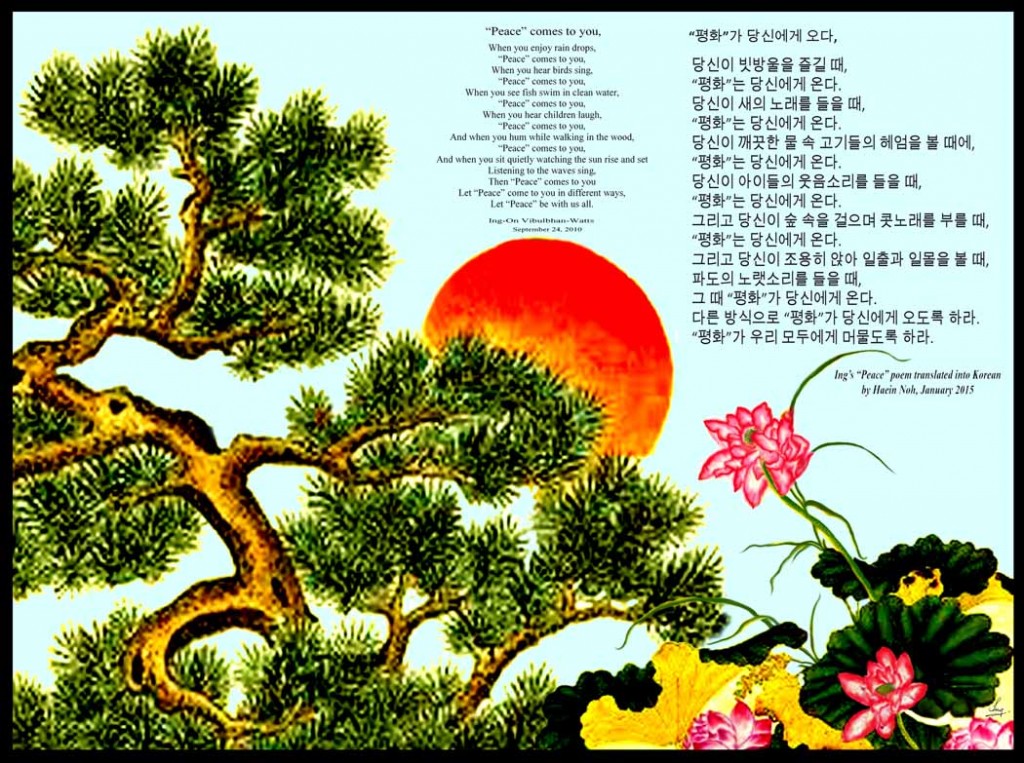

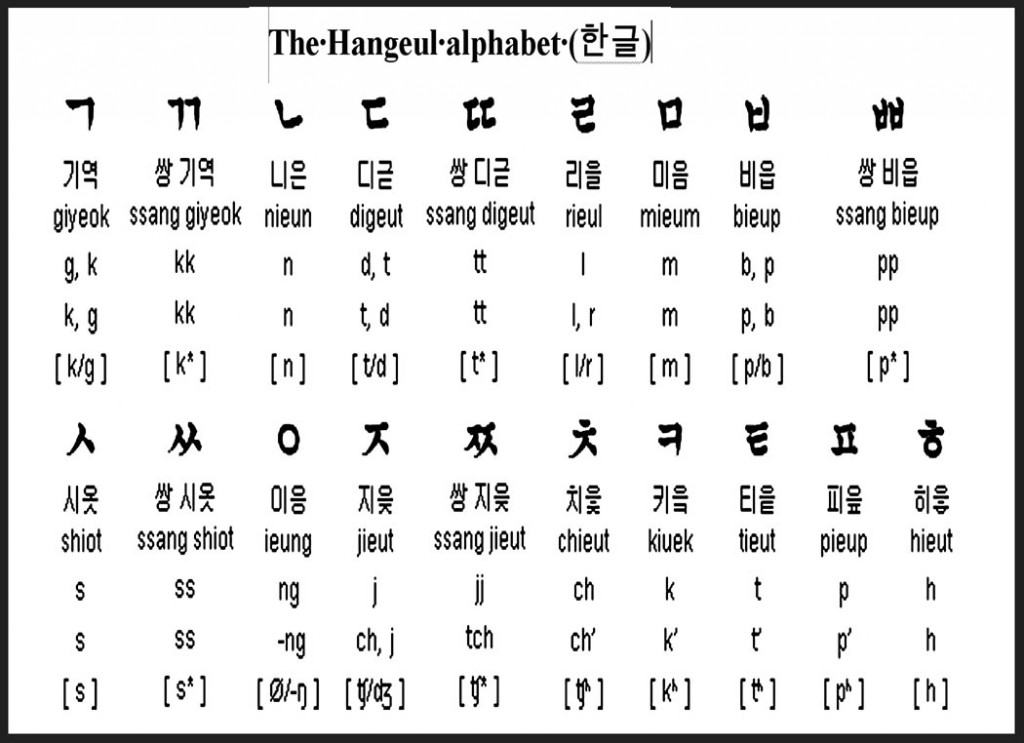
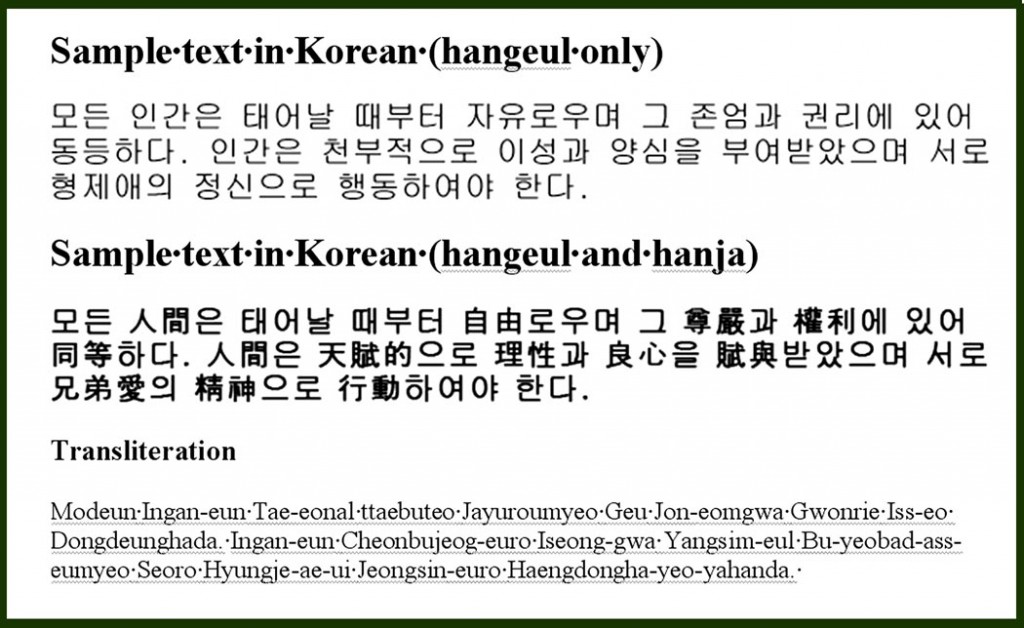 A recording of this text
A recording of this text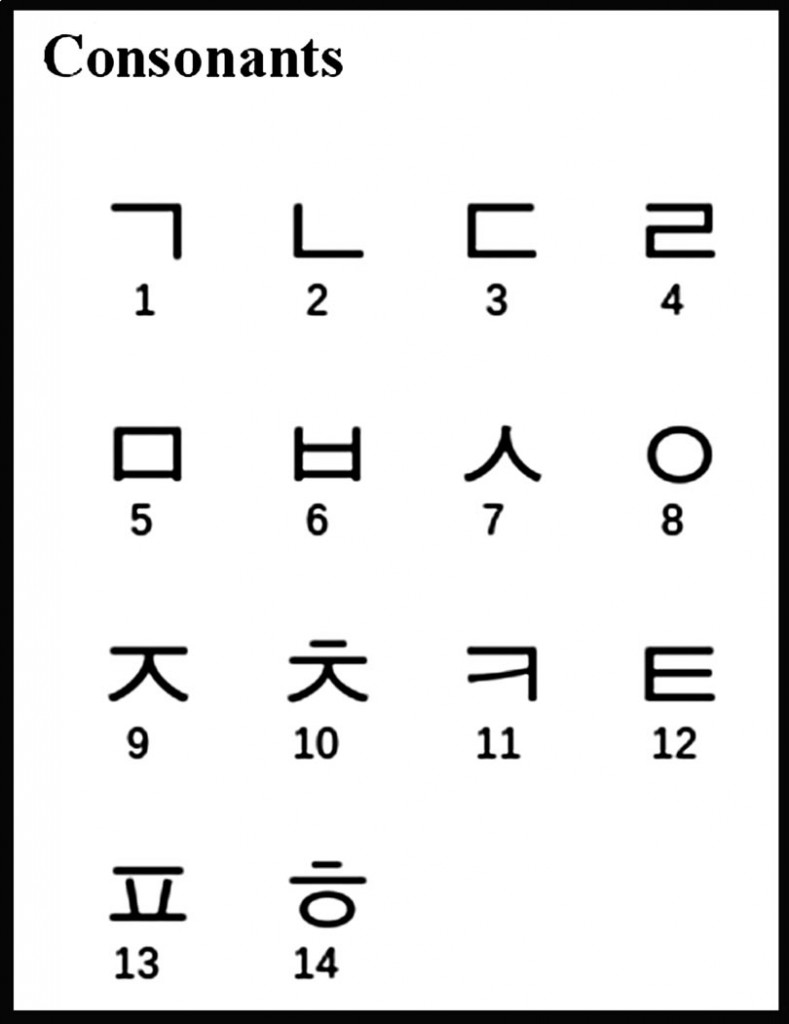
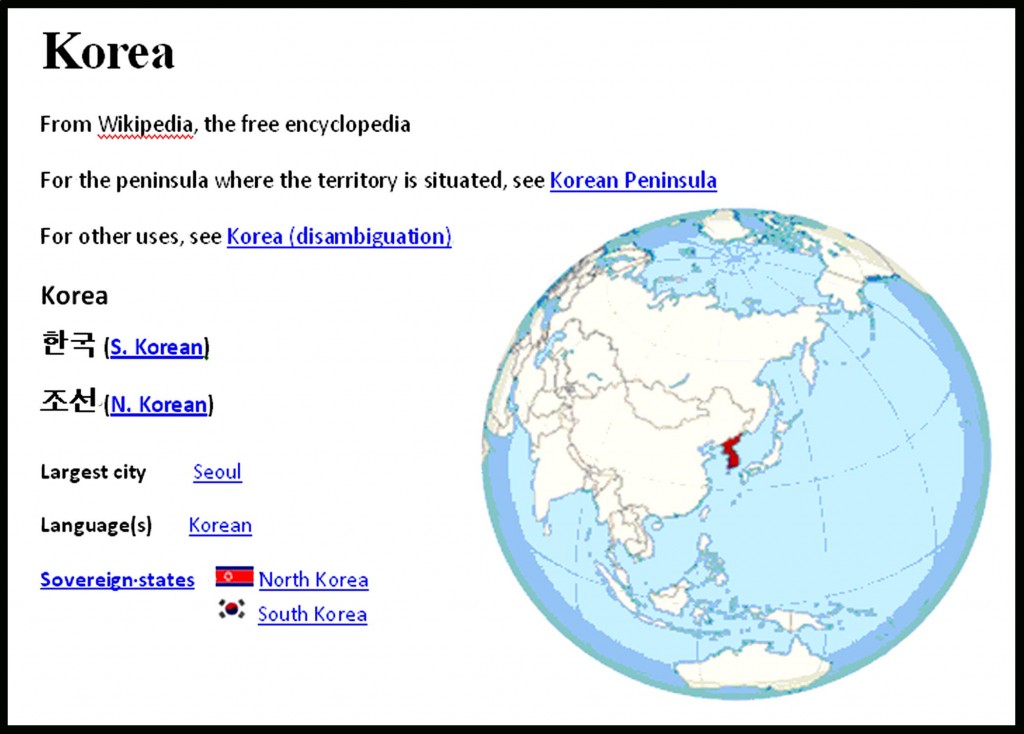
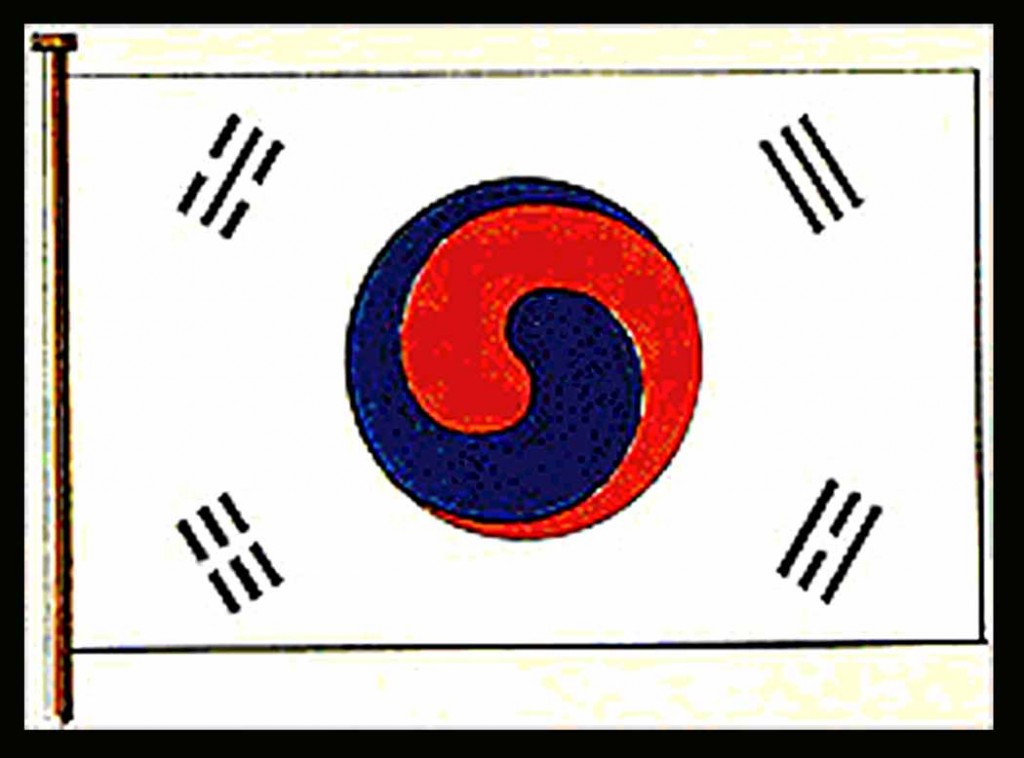

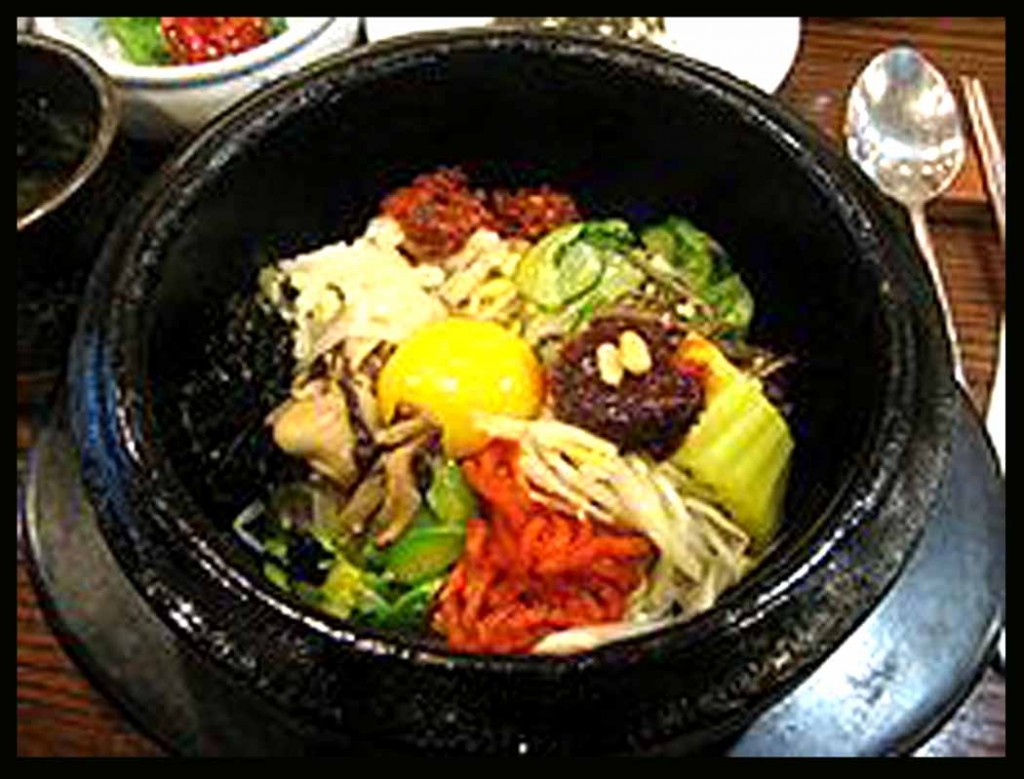 Dolsot bibimbap
Dolsot bibimbap
Leave a Reply